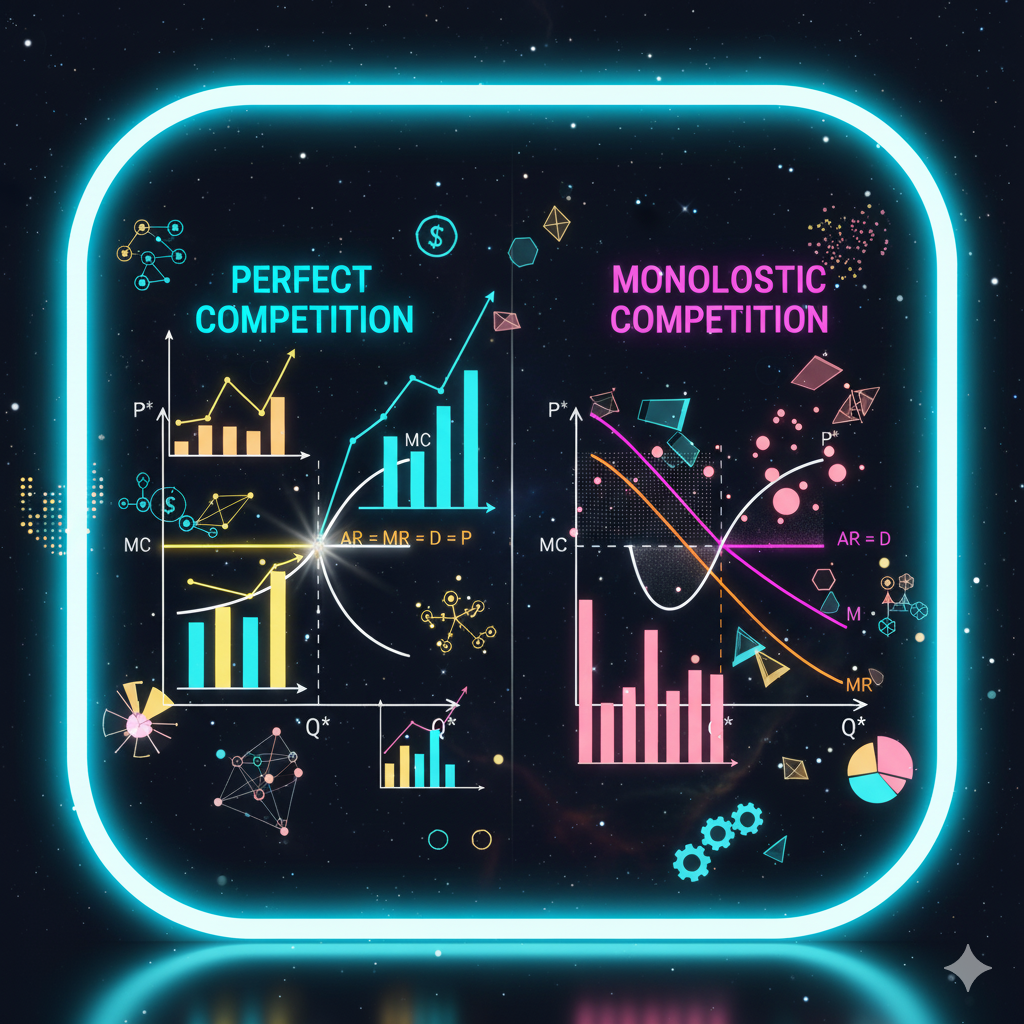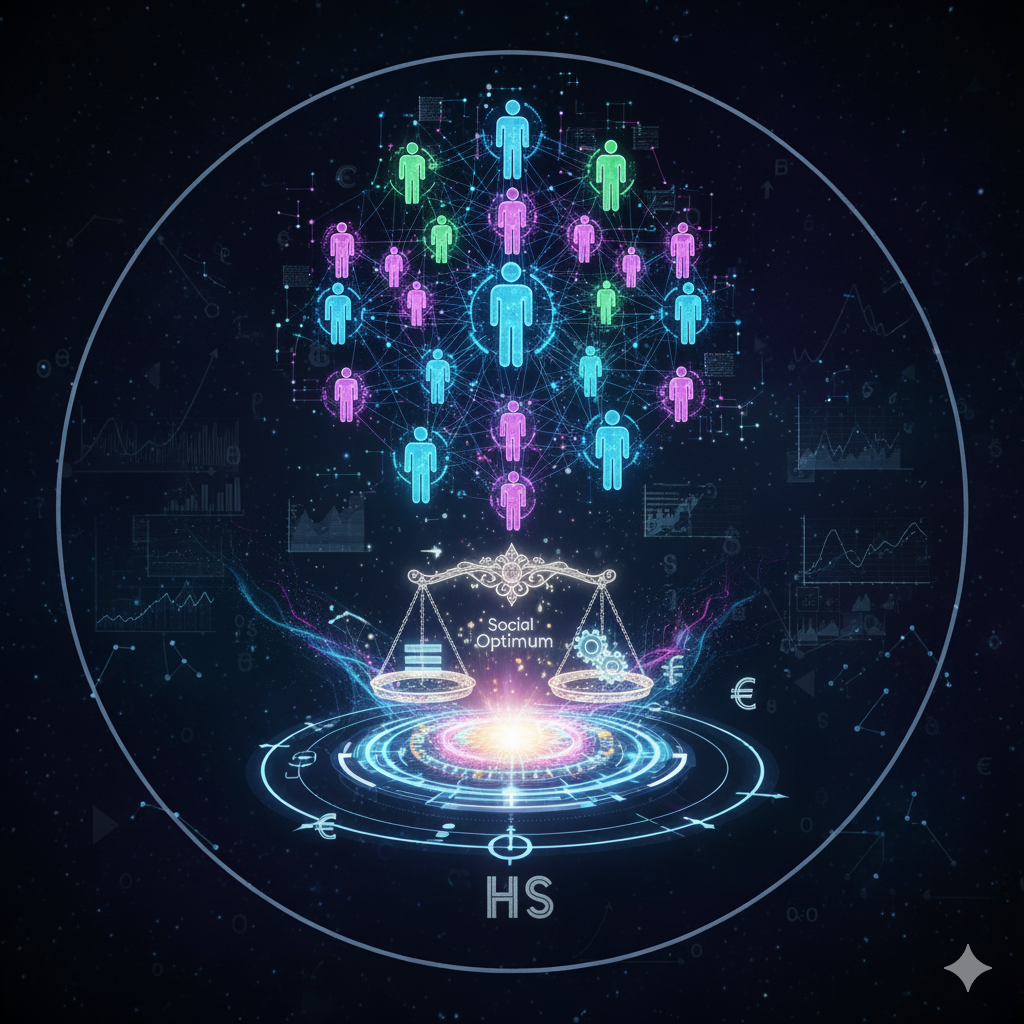Introduction
In microeconomics, understanding different market structures is fundamental to analyzing firm behavior, pricing decisions, and output determination. Two important market forms that are frequently studied are perfect competition and monopolistic competition.
- Perfect Competition (PC) is an idealized market where numerous firms sell homogeneous products, and no single firm can influence the market price.
- Monopolistic Competition (MC) is a realistic market structure where many firms sell differentiated products, giving each firm some degree of pricing power.
While both market forms share certain characteristics, they also differ significantly in key aspects such as product differentiation, pricing power, and the nature of demand curves. This article explores the main similarities and dissimilarities between the two market structures and provides diagrammatic explanations to illustrate these points.
Perfect Competition: A Brief Overview
Features of Perfect Competition
- Large Number of Buyers and Sellers: No single buyer or seller can influence the market.
- Homogeneous Products: All firms sell identical goods; no differentiation exists.
- Free Entry and Exit: Firms can enter or leave the market without barriers.
- Perfect Knowledge: Buyers and sellers have complete information about prices and quality.
- Price Taker: Firms accept the market price; they cannot set prices.
- Horizontal Demand Curve: Each firm faces a perfectly elastic demand curve at the market price.
Revenue and Profit Conditions
- AR = MR = Price: Since the firm is a price taker.
- In the short run, firms may earn supernormal profits or incur losses.
- In the long run, free entry and exit drive profits to normal profits (zero economic profit).
Diagram 1: Perfect Competition Equilibrium (Short Run and Long Run)
- Short run: MR = MC determines profit-maximizing output; supernormal profits may exist.
- Long run: Entry of new firms shifts supply, reducing price; AR = AC at equilibrium output.
Monopolistic Competition: A Brief Overview
Features of Monopolistic Competition
- Many Sellers: A large number of firms compete.
- Product Differentiation: Firms sell products that are slightly different (branding, quality, design).
- Freedom of Entry and Exit: Firms can enter or leave the market with relative ease.
- Some Price-Making Ability: Firms have some control over price due to differentiation.
- Downward Sloping Demand Curve: Each firm faces a negatively sloped demand curve, unlike horizontal in perfect competition.
Revenue and Profit Conditions
- AR > MR: Because to sell additional units, firms must lower the price slightly.
- Short Run: Firms may earn supernormal profits.
- Long Run: Entry of new firms erodes profits; economic profit = 0.
Diagram 2: Monopolistic Competition Equilibrium (Short Run and Long Run)
- Short run: Profit-maximizing output where MR = MC; supernormal profit possible.
- Long run: Entry reduces demand for each firm; AR tangent to AC curve, normal profits earned.
Similarities Between Perfect Competition and Monopolistic Competition
Despite differences, these two market structures share several common features:
1. Large Number of Sellers
- Both markets have many firms, preventing a single firm from dominating the market.
- Competition exists in both cases, though intensity differs due to product differentiation.
2. Freedom of Entry and Exit
- New firms can enter if profits exist, and firms can exit if they incur losses.
- This ensures that in the long run, only normal profits are earned.
3. Profit Maximization Objective
- Firms in both markets aim to maximize profits.
- Equilibrium output is determined where MR = MC.
4. Short-Run Possibility of Supernormal Profits
- Both market forms allow firms to earn supernormal profits in the short run.
- Example: A new product may attract high initial demand.
5. Existence of a Demand Curve for Individual Firms
- Each firm faces its own demand curve for its product, although the shape differs.
- In perfect competition, the demand curve is perfectly elastic, whereas in monopolistic competition, it is downward sloping.
6. Long-Run Equilibrium Ensures Normal Profit
- Due to free entry and exit, economic profits are zero in the long run in both markets.
- Firms produce output where AR = AC in the long run.
Diagrammatic Similarity:
- In both markets, long-run equilibrium occurs where the AR curve is tangent to AC curve, indicating normal profit.
Dissimilarities Between Perfect Competition and Monopolistic Competition
While the similarities exist, the differences are more pronounced, especially regarding product, price, and efficiency.
| Aspect | Perfect Competition | Monopolistic Competition |
|---|---|---|
| Nature of Product | Homogeneous | Differentiated |
| Price Control | No control (price taker) | Some control (price maker) |
| Demand Curve of Firm | Perfectly elastic (horizontal) | Downward sloping |
| Revenue Relationship | AR = MR = Price | AR > MR |
| Short-Run Profits | Supernormal profits possible | Supernormal profits possible |
| Long-Run Profits | Zero economic profit | Zero economic profit |
| Efficiency | Allocative efficiency (P = MC) and productive efficiency (MC = min AC) | Neither allocative (P > MC) nor productive efficient (MC ≠ min AC) |
| Nature of Competition | Pure price competition | Price and non-price competition (advertising, quality, brand) |
| Examples | Agricultural markets, stock exchange | Retail stores, restaurants, hair salons |
1. Nature of Product
- Perfect Competition: Standardized, identical products; consumers do not prefer one firm over another.
- Monopolistic Competition: Products differ in style, quality, or branding; consumers have preferences.
Diagram 3:
- Perfect competition: Horizontal demand curve for a firm.
- Monopolistic competition: Downward-sloping demand curve due to differentiation.
2. Price Control and Revenue
- Perfect Competition: No control over price; AR = MR = Price.
- Monopolistic Competition: Some control over price; MR < AR.
- Explanation: To sell more units, the firm must slightly reduce the price, reducing MR relative to AR.
3. Efficiency
- Perfect Competition: Achieves both productive efficiency (AC minimized) and allocative efficiency (P = MC).
- Monopolistic Competition: Inefficient in both respects.
- P > MC → allocative inefficiency
- AC not minimized → productive inefficiency
This is due to excess capacity in monopolistic competition. Firms do not produce at minimum AC in the long run.
Diagram 4: Excess Capacity in Monopolistic Competition
- Long-run equilibrium output (Q1) < minimum AC output (Qmin).
- Shows underutilization of resources compared to perfect competition.
4. Nature of Competition
- Perfect Competition: Pure price competition; no advertising; firms compete only via price.
- Monopolistic Competition: Non-price competition is significant; firms use advertising, packaging, and quality differentiation to attract customers.
5. Examples
- Perfect Competition: Agricultural products like wheat, rice, corn.
- Monopolistic Competition: Fast food chains, branded clothing, retail stores, coffee shops.
Diagrammatic Comparison
Diagram 5: Perfect Competition (Long Run)
- AR = MR = Price = P0, horizontal.
- AC tangent to AR → normal profit.
Diagram 6: Monopolistic Competition (Long Run)
- AR downward sloping.
- MR below AR.
- AC tangent to AR → normal profit, but output less than minimum AC (excess capacity).
Critical Analysis
- Efficiency:
- Perfect competition is theoretically ideal for efficiency.
- Monopolistic competition is more realistic but less efficient due to product differentiation and pricing power.
- Consumer Choice:
- Perfect competition offers no variety.
- Monopolistic competition offers variety and caters to diverse consumer preferences.
- Innovation and Advertising:
- Perfect competition discourages innovation (homogeneous products).
- Monopolistic competition encourages innovation and brand development.
- Market Realism:
- Perfect competition is largely theoretical.
- Monopolistic competition exists in most real-world markets.
Conclusion
Perfect competition and monopolistic competition share commonalities such as many firms, freedom of entry and exit, short-run profits, and long-run normal profits. However, they differ significantly in product nature, pricing power, demand curves, efficiency, and competitive strategies.
- Perfect Competition: Ideal for efficiency but lacks variety and realism.
- Monopolistic Competition: Realistic and consumer-friendly due to differentiation, but less efficient.
Diagrammatic Summary:
- PC: Horizontal AR = MR, long-run AC tangent to AR.
- MC: Downward-sloping AR, MR < AR, AC tangent to AR, output < Qmin (excess capacity).
Understanding these similarities and differences helps students, policymakers, and business managers analyze market behavior, pricing, and output decisions effectively.




